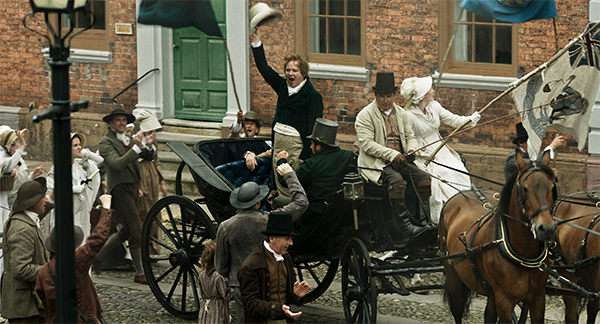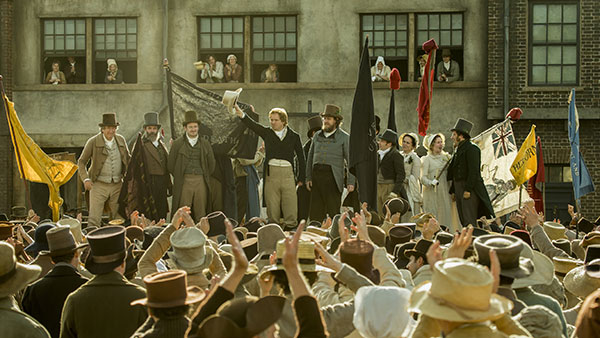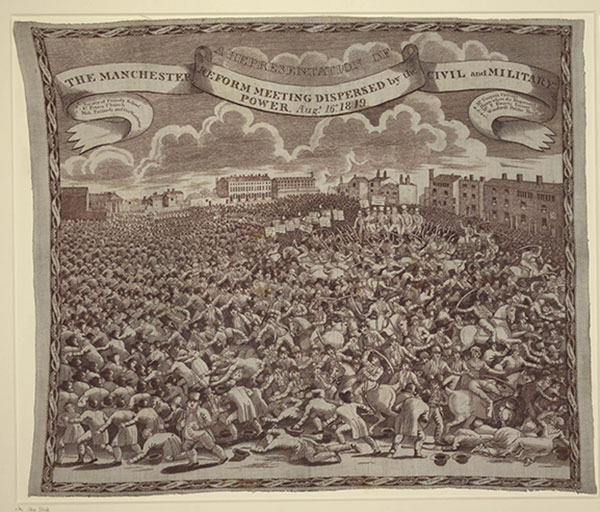Peterloo—an Irish tragedy?
Published in Features, Issue 4 (July/August 2019), Volume 27Amongst those killed and injured were a great many of the city’s Irish workers and their families.
By Mairtín Ó Catháin
This year marks the 200th anniversary of the infamous attack by government forces on a mass gathering of parliamentary reformers in St Peter’s Fields in Manchester, in which an estimated seventeen people were killed and 650 injured.
The events of the day are relatively well known, even if the longer-term effects remain an area of intense debate. The protest meeting was called by the Manchester Patriotic Union, one of a number of radical reform societies that had grown up over the previous few years seeking a broad platform of political and socio-economic change. The Irish formed an important and sometimes overlooked component in this reform movement and figured heavily among the casualties, but they also, perhaps unsurprisingly, figured on the other side as well.
The Irish in Manchester
Although not as famous as Liverpool for its Irish population, Manchester had a settled Irish community from at least the late eighteenth century. The demands of the Napoleonic wartime economy, growing socio-economic difficulties in Ireland and the opportunities afforded for workers in Lancashire’s expanding textiles industry saw large numbers of Irish migrants settle in Manchester. The town was a bustling centre of population and industry, notable for its large working-class element, its entrepreneurial spirit and, increasingly, for its social inequality. The Irish population has been estimated at 7,000–10,000 in 1819 and, perhaps predictably, formed distinct communities settled in recognisably ‘Irish’ areas, such as New Town and Ancoats in the north of the city and Little Ireland in the south. Prevailing attitudes labelled the Irish as both turbulent and easygoing, industrious and lazy, and conservative and radical, and they were therefore a ready target for a very wide range of establishment fears and suppositions. The background to this, of course, was the 1798 Rebellion, which in itself had brought waves of refugees to English and Scottish shores. These families and individuals represented both sides in the conflict, as well as many simply caught up in and anxious to escape the terrible violence and turmoil associated with it. The memory of 1798 and its legacy lived on in exile and was a prominent feature of the debate that fed into and out of the Peterloo massacre, from accusations about the conduct and character of the military, both English and Irish, to the attitudes and activism of the radicals.

Above: The mood was jubilant beforehand and a great many women were dressed in white, as depicted in Mike Leigh’s 2018 film Peterloo. (Film Four/Thin Man Films)
The morning of 19 August 1819 broke clear and warm as both protestors and the authorities began to prepare for the day ahead. The mood was jubilant and the crowds, with bands and banners and a great many women dressed in white, were joined by considerable numbers of the Irish. As the Middleton delegation passed with their green banner through New Town, the radical Samuel Bamford recorded their rapturous reception:
‘We were welcomed with open arms by poor Irish weavers, who came out in their best drapery, and uttered blessings and words of endearment, many of which were not understood … some of them danced, and others stood with clasped hands and tearful eyes, adoring almost, that banner whose colour was their national one, and the emblem of their green island home. We thanked them by the band striking up “St Patrick’s Day in the morning”. They were electrified, and we passed on, leaving those warm-hearted suburbans capering and whooping like mad.’

Above: The speakers on the platform—among them was Cork-born Mary Fildes, president of the Manchester Female Reform Society. (Film Four/Thin Man Films)
Meanwhile, proceeding along Deansgate from the south came the women of the Manchester Female Reform Society, with their own banner and flag carried by their 27-year-old president, the Cork-born Mary Fildes. She was accompanying the main speaker, ‘orator’ Henry Hunt, and was invited into his carriage and later onto the speaker’s platform, where she was depicted in a number of later illustrations of the protest.
Constables backed by Yeomanry cavalry
Soon after, around 1pm, the hustings were mounted by the speakers, including Hunt, who stood in front of a massive crowd in excess of 60,000 people. The magistrates, who occupied a nearby house, had declared the meeting an unlawful assembly and ordered their constables forward to effect the arrests of the platform party. A few days before, however, they had arranged for several parties of the military to be on stand-by at strategic points surrounding St Peter’s Square. Before the platform speeches began, therefore, the cavalry of the part-time Manchester and Salford Yeomanry moved into the crowd, who, as witnesses generally agree, were not overly perturbed and sarcastically cheered their passage alongside the constables. There was then a short reported silence before the Yeomanry began their attack without any real warning or provocation. At the subsequent inquest into the death of one of the protestors, a woman named Ann Jones gave her impressions:
‘I live in Windmill Street … within forty yards of the hustings. I saw the cavalry cutting and slashing men on their way to the hustings. After getting to the hustings they turned their horses round and rode over the people in all directions, still cutting and slashing. A number of wounded persons were taken into my house … I saw a great quantity of blood on the field, near the place where the hustings had stood. One of the special constables came into my house, and with great triumph exclaimed, “This is Waterloo for you—this is Waterloo!” … The rail in front of my house broke down with the pressure of the crowd, occasioned by the cutting of the cavalry, and a woman fell down and was taken up dead.’

Above: ‘A REPRESENTATION OF THE MANCHESTER REFORM MEETING DISPERSED by the CIVIL and MILITARY POWER, Aug. 16th, 1819’. (British Museum)
Amongst those killed and injured were a great many of the city’s Irish workers and their families. Michael Bush’s comprehensive research into the Peterloo affair has established that 97 of the recorded casualties (c. 15% of the total) were Irish. This was at a time when the Irish probably only accounted for around 10% of the population at most, so they were disproportionately affected in the attack. Bush was able to establish that 63 of the Irish casualties came from nearby New Town and Ancoats (where most of the Peterloo casualties were from), whilst another fourteen came from areas just outside the city. Arthur O’Neill, a 40-year-old weaver from Pigeon Street in Ancoats, was numbered among the dead. Attacked and bludgeoned by the constables and then caught in the crush of the crowd and incapacitated, he and a neighbour, Thomas Kelly, a 33-year-old weaver who had been trampled by the cavalry horses, were identified as leaders and arrested and imprisoned, O’Neill later dying of his injuries. Another Ancoats man, James Carrol, a 35-year-old calico printer, received a sabre-cut on the back of his head, had his right shoulder injured and was crushed by the crowd, putting him out of work for five weeks. Many of the women were particular targets for the authorities; Mary Fildes leapt from the platform as the police approached and was beaten by a number of constables wielding batons or staves. Four of those killed were women, and some of the Irish, such as Mary Daly from Coop Street in Ancoats, who had her wrist slashed by a sabre, sisters Ann and Rose McCabe (who were just seventeen and fourteen years old respectively), who were knocked over and trampled by horses, or Mary Martin, sabred on the head as her husband fell under the hooves of the charging cavalry, were clearly picked out by the Yeomanry. There was an anger and outrage, as Bush has noted, about women being seen to take a prominent role in the growing reform movement, even in a time when few dared to seek truly universal suffrage in extending the vote to women.
Orange magistrates
Two of the magistrates responsible for this onslaught, Ralph Fletcher and John Sylvester, were prominent Lancashire Orangemen, and a persistent theme in the historiography of British Orangeism is that several of those active against Lancashire radicals had previously served in Ireland during the 1798 Rebellion. The inference here is that the brutality and fervent loyalism associated with 1798 had been transposed to the north of England in the following years, with English rather than Irish republicans in the firing line. There is, of course, some truth to this interpretation. A mounted regiment, the Lancashire Greys or Lancashire Light Dragoons, had been active in Ulster in June 1798, but there is no evidence that any of the Manchester Yeomanry had served with this unit, and Sylvester’s own Lancashire and Salford Rifle Volunteers did not even go to Ireland in spite of claims to the contrary. The Lancashire Militia were involved in some bloody counter-revolutionary mopping up in Wexford and Tipperary in 1798; while Sylvester, and possibly some of the Yeomanry, may have been part of it, they arrived after the rebellion was over and did not face any opposition or fight any formal (or informal) engagements. Rather, much of their time was taken up with balls and banquets as hosts of the local propertied families. Orange warrants were apparently issued and the soldiers brought these back, but the subsequent reputation of their Lancashire lodges was more than a trifle vainglorious.
Ironically, one of the few members of the Manchester and Salford Yeomanry whom we can positively identify appears to have been an Irish Catholic. Edward Meagher, the regiment’s trumpeter, was a tailor living in Deansgate in the city, though originally from Cork. A number of men and women claimed that he was responsible not only for leading the charge at Peterloo but for wantonly cutting a large number of protestors with his sabre. A few weeks afterwards he was recognised in the street and harangued as a ‘damned Irish scamp’ responsible for the bloodshed on St Peter’s Field. Meagher barricaded himself into his house and a small crowd of people threw stones. He then appeared at an upstairs window and fired some shots, injuring two of the demonstrators; he was subsequently arrested but eventually returned to Ireland. Henry Hunt, as MP for Preston, claimed in the House of Commons in 1832 that no less than Daniel O’Connell had informed him that Meagher ‘had made a boast among his countrymen that he had shed more Saxon blood on that day than had ever been shed by any single Irishman before his time’. What happened to this particular ‘Meagher of the sword’ is unclear but he, like his comrades, seems never to have faced justice for his actions.
Connaught Rangers
Another victim of the events of Peterloo appears to have been Thomas Buckley. His age is not known but he lived in Chadderton, just outside Manchester, and was killed by being struck with a sword and then stabbed with a bayonet. It seems likely that he was one of the many protestors trying to escape St Peter’s Square at its north-east corner as the cavalry advanced, only to find their way blocked by a party of the 88th Foot, or the Connaught Rangers. After one of the Yeomanry, named Barnes, accidentally came off his horse in this area, the troops were ordered forward to protect him as the crowds rushed pass. A journalist for the Morning Chronicle, Francis Shaw, gave his impressions at a subsequent inquest:
‘I heard some kind of exclamation from the people … the infantry were formed in the same position as previous to a charge. Barnes, I believe, got upon his horse, but I do not know what became of him … While I remained behind they brought the body of John Hulme, a young gentleman of Mosley Street, carried on a shutter by four persons.’
The 88th appear to have bayoneted and clubbed with their rifle butts a number of men and women fleeing the field, including Buckley. Later that evening they clashed with an angry mob in the New Cross area and opened fire, killing at least another two people. The regiment had returned from the Napoleonic wars in 1817, and shortly before Peterloo an attempt had apparently been made by radicals to infiltrate the ranks.
Public reaction to Peterloo seems to have been quite muted in Ireland, perhaps because it paled somewhat into insignificance when compared with the violence of 1798. There was also the continuing turbulence of the Irish countryside in these years, culminating in some ways in the violence of the Tithe War and the distraction of the ‘Colleen Bawn’ murder in the summer of 1819. There was certainly no recognition that this was an Irish as well as an English tragedy, contingent with and a culmination of Ireland’s own reform and revolutionary movements of the previous three decades, although perhaps that is how Peterloo, at least in part, needs to be recognised in modern Irish history.
Mairtín Ó Catháin is Senior Lecturer in Modern Irish History at the University of Central Lancashire.
FURTHER READING
M. Bush, The casualties of Peterloo (Manchester, 2005).
K. Navickas, Loyalism and radicalism in Lancashire, 1798–1915 (Manchester, 2009).
R. Poole (ed.), Return to Peterloo (Manchester, 2015).
















